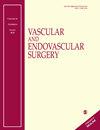求助PDF
{"title":"Applying Artificial Intelligence to Predict Complications After Endovascular Aneurysm Repair.","authors":"Becky Long, Danielle L Cremat, Eduardo Serpa, Sinong Qian, John Blebea","doi":"10.1177/15385744231189024","DOIUrl":null,"url":null,"abstract":"<p><p><b>Objective:</b> Complications after Endovascular Aneurysm Repair (EVAR) can be fatal. Patient follow-up for surveillance imaging is becoming more challenging as fewer patients are seen, particularly after the first year. The aim of this study was to develop an artificial intelligence model to predict the complication probability of individual patients to better identify those needing more intensive post-operative surveillance. <b>Methods:</b> Pre-operative CTA 3D reconstruction images of AAA from 273 patients who underwent EVAR from 2011-2020 were collected. Of these, 48 patients had post-operative complications including endoleak, AAA rupture, graft limb occlusion, renal artery occlusion, and neck dilation. A deep convolutional neural network model (VascAI<sup>©</sup>) was developed which utilized pre-operative 3D CT images to predict risk of complications after EVAR. The model was built with TensorFlow software and run on the Google Colab Platform. An initial training subset of 40 randomly selected patients with complications and 189 without were used to train the AI model while the remaining 8 positive and 36 negative cases tested its performance and prediction accuracy. Data down-sampling was used to alleviate data imbalance and data augmentation methodology to further boost model performance. <b>Results:</b> Successful training was completed on the 229 cases in the training set and then applied to predict the complication probability of each individual in the held-out performance testing cases. The model provided a complication sensitivity of 100% and identified all the patients who later developed complications after EVAR. Of 36 patients without complications, 16 (44%) were falsely predicted to develop complications. The results therefore demonstrated excellent sensitivity for identifying patients who would benefit from more stringent surveillance and decrease the frequency of surveillance in 56% of patients unlike to develop complications. <b>Conclusion:</b> AI models can be developed to predict the risk of post-operative complications with high accuracy. Compared to existing methods, the model developed in this study did not require any expert-annotated data but only the AAA CTA images as inputs. This model can play an assistive role in identifying patients at high risk for post-EVAR complications and the need for greater compliance in surveillance.</p>","PeriodicalId":23530,"journal":{"name":"Vascular and Endovascular Surgery","volume":" ","pages":"65-75"},"PeriodicalIF":0.7000,"publicationDate":"2024-01-01","publicationTypes":"Journal Article","fieldsOfStudy":null,"isOpenAccess":false,"openAccessPdf":"","citationCount":"1","resultStr":null,"platform":"Semanticscholar","paperid":null,"PeriodicalName":"Vascular and Endovascular Surgery","FirstCategoryId":"3","ListUrlMain":"https://doi.org/10.1177/15385744231189024","RegionNum":4,"RegionCategory":"医学","ArticlePicture":[],"TitleCN":null,"AbstractTextCN":null,"PMCID":null,"EPubDate":"2023/7/10 0:00:00","PubModel":"Epub","JCR":"Q4","JCRName":"PERIPHERAL VASCULAR DISEASE","Score":null,"Total":0}
引用次数: 1
引用
批量引用
Abstract
Objective: Complications after Endovascular Aneurysm Repair (EVAR) can be fatal. Patient follow-up for surveillance imaging is becoming more challenging as fewer patients are seen, particularly after the first year. The aim of this study was to develop an artificial intelligence model to predict the complication probability of individual patients to better identify those needing more intensive post-operative surveillance. Methods: Pre-operative CTA 3D reconstruction images of AAA from 273 patients who underwent EVAR from 2011-2020 were collected. Of these, 48 patients had post-operative complications including endoleak, AAA rupture, graft limb occlusion, renal artery occlusion, and neck dilation. A deep convolutional neural network model (VascAI© ) was developed which utilized pre-operative 3D CT images to predict risk of complications after EVAR. The model was built with TensorFlow software and run on the Google Colab Platform. An initial training subset of 40 randomly selected patients with complications and 189 without were used to train the AI model while the remaining 8 positive and 36 negative cases tested its performance and prediction accuracy. Data down-sampling was used to alleviate data imbalance and data augmentation methodology to further boost model performance. Results: Successful training was completed on the 229 cases in the training set and then applied to predict the complication probability of each individual in the held-out performance testing cases. The model provided a complication sensitivity of 100% and identified all the patients who later developed complications after EVAR. Of 36 patients without complications, 16 (44%) were falsely predicted to develop complications. The results therefore demonstrated excellent sensitivity for identifying patients who would benefit from more stringent surveillance and decrease the frequency of surveillance in 56% of patients unlike to develop complications. Conclusion: AI models can be developed to predict the risk of post-operative complications with high accuracy. Compared to existing methods, the model developed in this study did not require any expert-annotated data but only the AAA CTA images as inputs. This model can play an assistive role in identifying patients at high risk for post-EVAR complications and the need for greater compliance in surveillance.
应用人工智能预测血管内动脉瘤修复术后并发症。
目的:血管内动脉瘤修复(EVAR)术后并发症可能是致命的。随着患者越来越少,特别是在第一年之后,患者随访监测成像变得越来越具有挑战性。本研究的目的是开发一种人工智能模型来预测个体患者的并发症概率,以更好地识别那些需要更密切的术后监测的患者。方法:收集2011-2020年273例行EVAR的AAA术前CTA三维重建图像。其中48例患者出现术后并发症,包括内漏、AAA破裂、移植物肢体闭塞、肾动脉闭塞和颈部扩张。我们建立了一个深度卷积神经网络模型(VascAI©),利用术前3D CT图像预测EVAR后并发症的风险。该模型使用TensorFlow软件构建,并在谷歌Colab平台上运行。使用随机选择的40例有并发症患者和189例无并发症患者作为初始训练子集对AI模型进行训练,其余8例阳性和36例阴性患者对其性能和预测准确性进行测试。采用数据降采样方法缓解数据不平衡,采用数据增强方法进一步提高模型性能。结果:对训练集中的229例病例完成了成功的训练,并应用于预测出的性能测试用例中每个个体的并发症概率。该模型的并发症敏感性为100%,并能识别出所有EVAR后出现并发症的患者。在36例无并发症的患者中,16例(44%)被错误预测为出现并发症。因此,结果表明,在识别将从更严格的监测中受益的患者方面具有出色的敏感性,并且在56%的不发生并发症的患者中降低了监测频率。结论:人工智能模型可以较准确地预测术后并发症的发生风险。与现有方法相比,本研究开发的模型不需要任何专家注释的数据,只需要AAA CTA图像作为输入。该模型可在识别evar后并发症高风险患者和提高监测依从性方面发挥辅助作用。
本文章由计算机程序翻译,如有差异,请以英文原文为准。

 求助内容:
求助内容: 应助结果提醒方式:
应助结果提醒方式:


